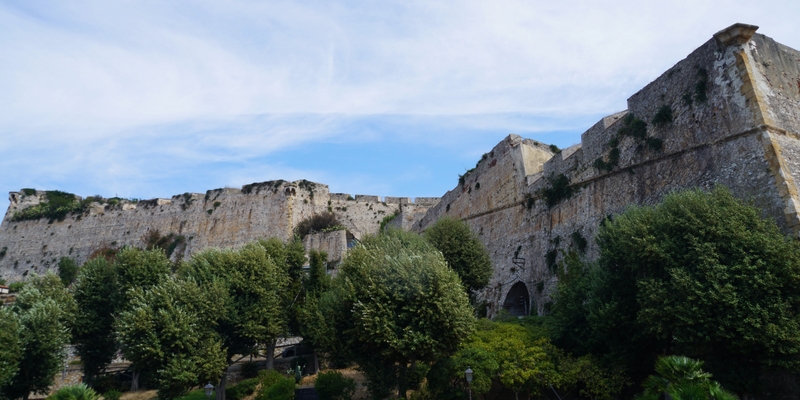5 Days in Elba: September 10 – 14, 2016
Background – The primary purpose of this 3-month journey is to join a 26-day overland trip in Africa on October 22. I then pick a 15-day GR20 hiking trip in Corsica beginning on September 18. I prefer direct flights and decide to use Rome as the base. As a result, I would spend five days in Elba (September 10 -14) before going to Corsica and 17 days in southern Italy (October 8 – 18) before departing for Cairo.
Brief History of Elba
From very ancient times, Elba famous for its iron mines, had been an important Mediterranean trading centre. It was invaded by the Etruscans, later (after 480 BC) by the Romans, the Ostrogoths and the Lombards in the Middle Ages. It was acquired by Appiani, Lords of Piombino when Pisa was sold to the Visconti of Milan in 1398. In 1544, pirates from North Africa devastated Elba and the coast of Tuscany. In 1546, part of the island was handed over to Cosimo I de’Medici while the rest of the island was returned to Appiani in 1577. In 1596, Philip II of Spain took Porto Azzurro and built two fortresses there.
In 1802, the island was taken by France. Following the Treaty of Fontainebleau, Napoleon I was exiled to Elba after his forced abdication in 1814. The Emperor arrived in Portoferraio on May 30, 1814 as the nominally sovereign of Elba where he was allowed to keep a personal guard of 600 men. During his 300-day stay on the island, Napoleon carried out a series of economic and social reforms to improve the quality of life of the islanders. He returned to France on February 26, 1815 for the Hundred Days. Following defeat at the Battle of Waterloo, Napoleon was exiled to St Helena where he died in 1821. In the Congress of Vienna, Elba was given to the Grand Duchy of Tuscany. In 1860, it became part of the new unified Kingdom of Italy.
Elba Today
With an area of 224km² and about 30,000 inhabitants, Elba is the third largest island in Italy after Sicily and Sardinia and the largest island of the Tuscan Archipelago. The terrain is quite varied and divided into several areas based on geomorphology. The eastern part dominated by Monte Calamita is the oldest part of the island formed over 3 million years ago where iron has been mined. The central part is mostly flat with the narrowest section reducing to four kilometres. The western part of the island is rugged and dominated by Monte Capanne(1,018m), the highest point on the island.
The island is divided into eight municipalities namely Portoferraio (the principal town and port), Campo nell’Elba, Capoliveri, Marciana, Marciana, Porto Azzurro, Rio Marina and Rio nell’Elba. Part of the Archipelago Toscano National Park, Elba is a hike’s paradise with dozens of self-guided walks as well as a 100km-long hike across the island. Its 147km-long coast is studded beautiful beaches and picturesque coves and small towns. Elba has well-maintained roads and an efficient and cheap public bus service.
September 10 Saturday: Hong Kong (GMT+8) – Rome, Italy – Corsica (GMT+2)
I departed HK at 0040hr. The plane was full. I was tired and managed to sleep for a few hours and watched a couple of films in between. I arrived at Rome in fairly good shape shortly after 7:30am local time. I like the public transportation system in Europe. In Italy, the train is cheap though it might not always on time. To go Elba, one can take the train and bus to Piombino and then take a ferry. The island is about 10km from the mainland: the fast ferry takes 30min while the normal ferry takes an hour.
I took a train from the airport around 8:30am to Ostiense (€ 8) and then a regional train in the direction of Pisa (€ 13,52) at 10:25am. By 1:30pm, I was already at the port and bought a normal ferry ticket on the Moby Line (about € 16). The boat left at 2pm and I was at Portoferraio shortly after 3pm. I had booked three nights’ accommodation at Residence Alithai in Magazini (€171) which is 7km from the port. The hotel had advised me to take Bus Line 2 (€ 2.1 a single journey) at 3:45pm. I was at the residence by 4pm and got a large self-contained one-bedroom apartment with four beds and a patio.
As I had to wait till 7pm for dinner, I explored the area on foot. Agrotourism centred on wine is popular here. I visited a pretty vineyard called ‘La Chiusa’ which also provides nice accommodation. To support the local economy, I happily paid €6 for wine tasting. The white wine is refreshing, fruity with sweet aroma. But theone-year old red wine and a dessert are so-so. I took a bottle of white wine for €10. Then the lady told me to pay only€4 as the wine tasting would be free for customers. A nice surprise!
I went to a supermarket and got a melon and ham which would go well with white wine. I had a seafood sampler as starter, fish with pasta as the main course and a glass of white wine for €33. The starter is delicious but the main course is disappointing. I was ready for bed at 9pm.
September 11 – 14: 4 Fun Days in Elba
Most visitors tour around the island by car. For me, I prefer to hike and the cross-island hike looks tempting. But as I do not want to drive nor have the time for a long hike, I am happy to see the island as much as possible within five days by bus, boat and on foot. I indeed had a wonderful time.
A. Sightseeing on Foot
I. Portoferraiothe principal municipal in Elba is rich in history. There are three popular itineraries named after the Roman, Medici and Napoleon all centred around the old town and the port. I enjoyed walking along the colourful harbour before entering the Sea Gate to arriveat a picturesque main square (Piazza Della Repubblica). On one side is the Duomo (Cathedral)which is small and peaceful.
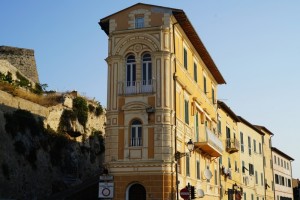 |
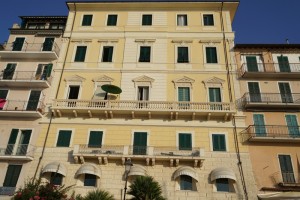 |
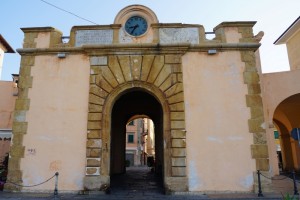 |
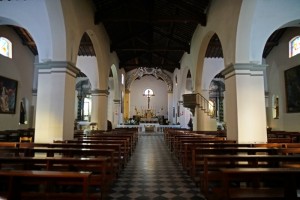 |
I returned to the harbour at the end of which is the Archaeological Museum of Linguella. Ibrought a combined ticket for four attractions for €7. Inside the museum, there are plenty of exhibits of ceramics, iron pieces, coins etc illustrating the importance of Elba famous for its iron and as a trading port. The receptionist gave me a note with brief information in English. Outside the building stands the the Martello Tower (16th century) and remains of a Roman villa (1 BC). Iwalked back to the old town which has a prominent municipal building with fading pinkish paint. The Church of S. Sacramento is small with rich Baroque decorations.
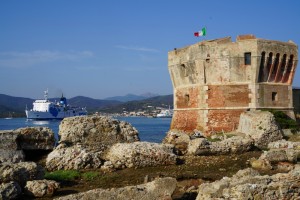 |
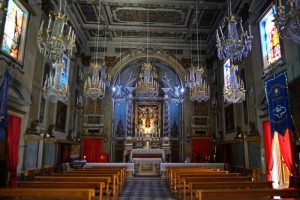 |
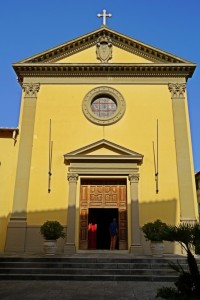 |
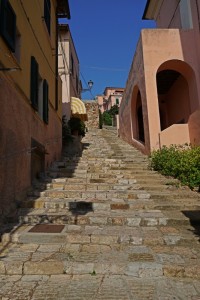 |
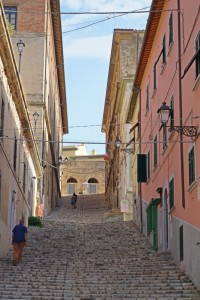 |
I walked along the cobbled stone path and soon reached Villa del Mulini, the residence of Napoleon, which is modest by any standard. I am surprised by the lack of information on how he had spent his 300 days on the island. The most interesting exhibit for me is Napoleon’s camp bed where he must have spent a lot of his time while on the road or in battle fields. The views from the house is magnificent. But I somehow missed the opportunity to visit Chiesa della Reverenda Misericordia which Napoleon went for service. I also missed out on Forte Stella.
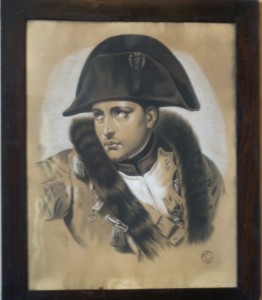 |
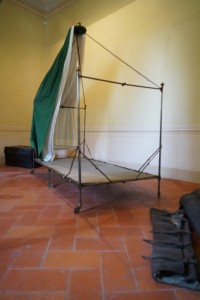 |
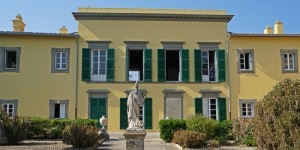 |
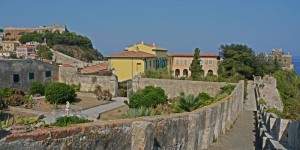 |
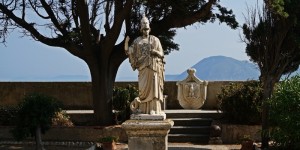 |
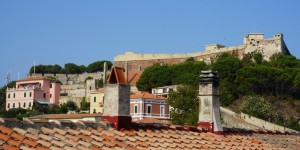 |
I followed the fortress wall and soon reached the Falone Fortress situated on the highest point of Portoerraio (79m above sea level). Constructions began in 1548 under Cosimo I, Grand Duke of Tuscany with the approval of Charles V, King of Spain.
On Day 4, I also had another opportunity to visit the old town for the last time. I went uphill to visit the Teatro del Vigilanti before it closed at 1pm. Then I had a seafood lunch in the main square.
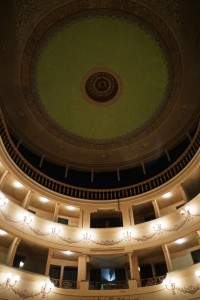 |
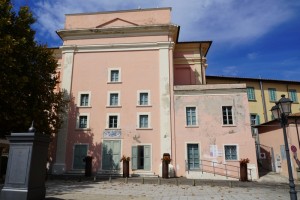 |
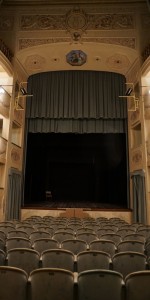 |
After lunch, I took a bus to San Martino about 5km from Portoferraio to visit Napoleon’s house. The setting of the house in the wood with distant views of Portferraio is serene and beautiful. But the house looks bare and miserable. Once again, there is no information on his life here. All I could find is minimal information on the furniture.
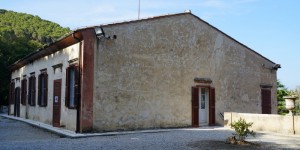 |
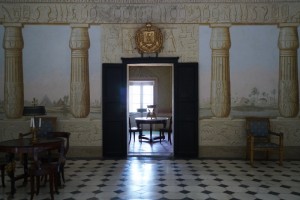 |
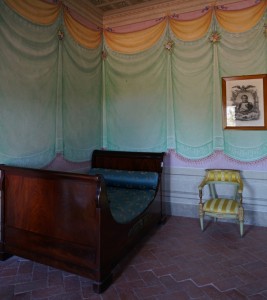 |
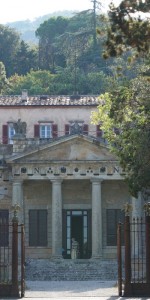 |
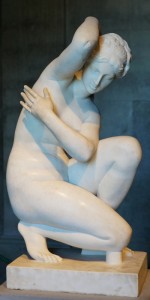 |
After San Martino, I returned to Portoferraio. As I still had time, I walked to the Spiaggia delle Ghiaie which is a popular beach.
II. Enfola. On Day 3, I took a self-guided Enfola Walk. I had to take the 10:20am Line 6 bus to Viticcio and got off at the top of a hill. I took about two hours to complete the walk which is fairly easy and well – marked with a white and red mark.
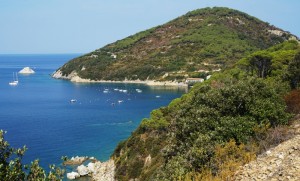 |
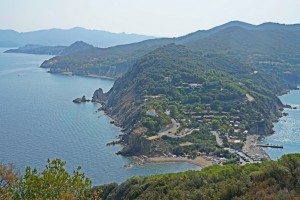 |
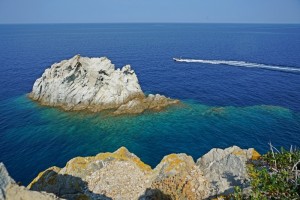 |
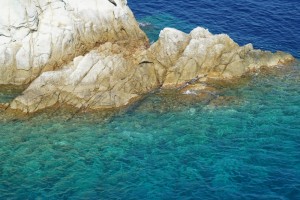 |
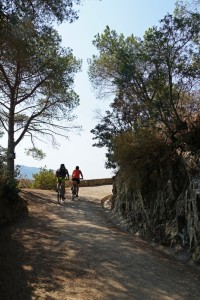 |
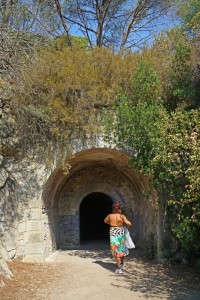 |
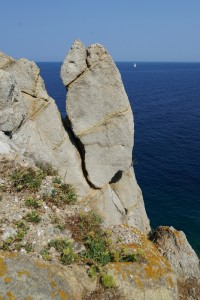 |
Enfola is one of Elba’s most important promontories in terms of the beauty of its landscape, its flora and fauna and history including tuna fishing and coastal defense. I followed the circular walk around Mt Elba and then another downhill path to see the Nave rock. I had fabulous views of the beautiful northern shoreline. Then I walked to Viticcio for a glass of wine before taking the 1:40pm bus back to Portoferraio.
B. Elba By Bus
Elba despite its small size and population, has a commendable public bus service. A 6-day bus pass only costs €22. I did not find it out till the second day after having purchased two single tickets for €4,20. Anyway, whatever I have paid (€26,20 in total) is far below the cost of the service. There are five daily buses on Line 2 from Portoferraio to Bagnai passing through Magazini. I normally took the second bus around 9:15am to Portoferraio and returned to Magazini on the last bus at 5:45pm. During my brief stay, I had two excellent scenic bus rides.
First, acircular routeto the west coast. After a 3-hour city walk on Day 2, I decided to sit back and relax by taking a bus ride. The staff of the bus terminal suggested me take the Portoferraio – Pomonte – Portferraio route which essentially goes round the western part of the island in three and a half hours. I got on the bus at 1:15pm and made a stop-over at Marciana Marina which is picturesque with an old town square and many eateries along the beach. I loved to have lunch before taking the 3:50pm bus. But as I would rather spend the time exploring the place than dining, I had to miss lunch.
The next major town is Marciana perching high on the mountain. After that, the road winds down to the beautiful coast passing through S Andrea, Chiessl to Pomonteon the west side before turning south to reach Seccheto,Cavoli, Campo Nell’ Elba and Marina di Campo which is the centre of water sport activities and boat cruises.
The journey back to Portoferraio goes through the central lowland interpersed with vineyards. I got back to the bus terminal in good time and got on the last bus to Magazini at 5:45pm. I had a most enjoyable ride!
Second, the eastern route to Cavo. After a 3-hour hike at Cape d’Enfola on Day 3, I took the bus at 2pm to see the eastern part of the island. The bus first went all the way up to Capoliveri which looks interesting affording commanding views over the central part and mountain ranges of the island. It then went downhill to reach Porto Azzurro which is pretty but touristic. I loved to get off for a stroll but decided to stay on to see Cavo at the end of the route first.
The bus went slowly along the mountain road till its arrived at Rio Marina an old picturesque port with a Spanish tower. I had an urge to get off and spend sometime here. But I remained on the bus and reached Cavo before 3:30pm. I looked at the timetable and planned to get on the next bus to and off at Rio Marina. Somehow I got the time mixed up thinking it would depart at 3:51pm. After having an ice-cream, I returned to the terminal at 3:45pm only to find the bus had gone. I looked at the timetable again and then realised I had made a mistake: the bus had left at 3:38pm and the next one would be at 4:51pm. Cavo looks boring unless one plans to embark on the 50-km trek across the island.
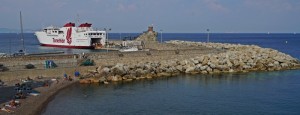 Luckily I saw a lady with a dog Bruno. She was heading to Rio Marina and kindly gave me a lift. I strolled around enjoying views of the Spanish tower and the beautiful coast.
Luckily I saw a lady with a dog Bruno. She was heading to Rio Marina and kindly gave me a lift. I strolled around enjoying views of the Spanish tower and the beautiful coast.
I resumed my bus ride shortly after 5pm thinking. I feared the last bus to Magazini would have gone by the time I got back to Portoferraio. Miraculously, the bus did not go through Capoliveri this time and I arrived at the road junction to Magazini before 6pm. As a result, I was able to catch my bus just in time saving me a 2-3km walk back to Residence Alithai. It’s my lucky day!
C. Elba By Boat
I. Round-island boat trip. Elba has a coastline of 147km. I discovered a most value-for-money boat trip (€35) leaving at 9:30am from Marina di Campo every Tuesday. On Day 4, I got up early to catch the first bus to Portoferraio at 7:18am followed by a connecting bus to Marina di Campo at 7:45am. As it’s a direct bus, it took only 30 minutes. I had over an hour walking around this busy tourist seaside town full of hotels and restaurants. The harbour is crowded with yachts, sailing and cruise boats while the beach is lined with countless sun-umbrellas. Not a place for me!
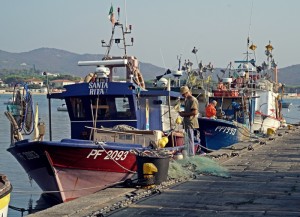 |
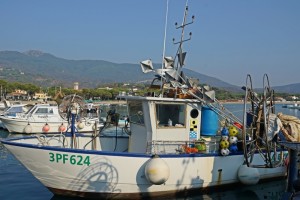 |
The boat was full (I guess with about 100 passengers). I had a 6-hour long cruise round the island with three swimming stops. The boat first sailed along the southern side of the island passing by Gulf of Lacona and Cape of Stella before a swim stop at Punta Calamita where I saw many abandoned mine sites.
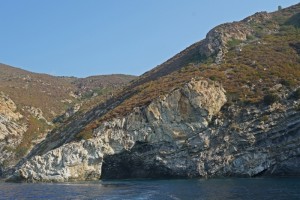 |
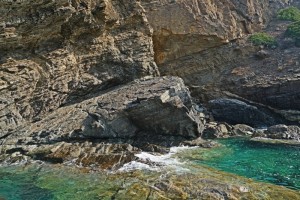 |
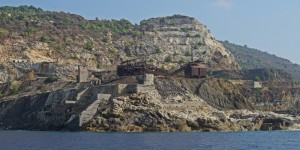 |
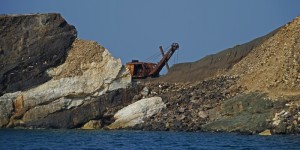 |
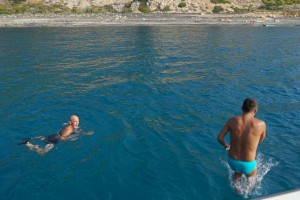 |
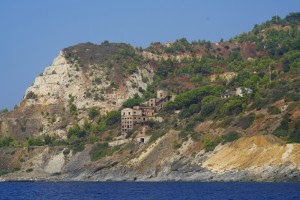 |
Then we sailed past Porto Azzurro before turning eastwhen Rio Marina came into view. After Cavo and Cape Vita, we were sailing along the northern coast. Owing to the angle of the sun rays, I had hazy views of Portoferraio and its imposing fortresses and the Spiaggie Bianche. We had better light when approaching Cape Enfola.
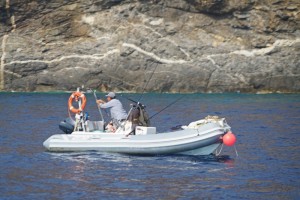 |
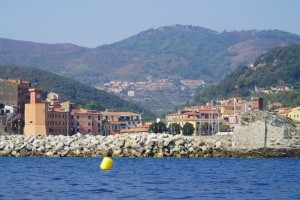 |
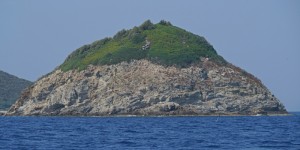 |
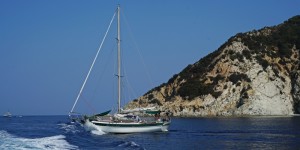 |
We stopped at the Gulf of Viticcio for swim and lunch. The water is clear, refreshing and cool. While the staff prepared pasta for lunch, most of the passengers went in for a quick dip. I had a bowl of pasta with tomato sauce. I had not expected to be served lunch on board.
The sun was now behind us and we had good views of Marciana, MarinaMarciana and SAndrea with the imposing the Monte Capanne range as the backdrop.
The boat turned west passing by Chiessland Pomontebefore turning south with the final swim stop at Fetovaia. Today I enjoyed my first as well as last swim in Elba. The boat sailed close to Grotta Azzurra before taking us back to Marina di Campo.
On the boat, I met four Italians (Rita, Tina and her husband and Justina). We all belong to the jolly and healthy 50+ group and had a great time! Rita invited me to stay with her whenever I returned to Italy. I always find Italians hospitable and friendly. 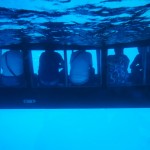
II. Boat Excursion & Underwater Viewing
I had been on a yellow submarine in the Red Sea once and glass-bottom boats numerous times for underwater viewing. On Day 4, I joined a 2-hour trip on M/N Nautilus (€18)which took me all the way to Cape d’Enfola and Gulf of Viticcio before returning to the iconic Lo Scoglietto with a light house. Here all passengers descended to the lower level and could see the sea grass and fish through the glass windows. In a way the experience is similar to underwater-viewing in a submarine. The water was clear. I saw plenty of fish but they were not colourful or impressive.
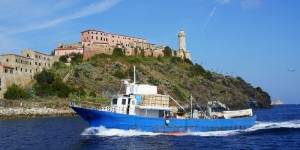 |
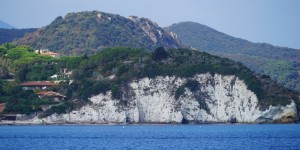 |
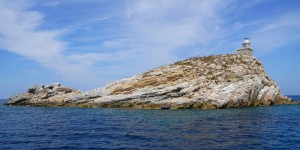 |
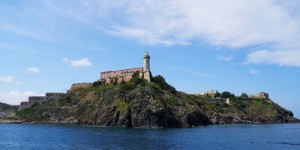 |
Leaving for Corsica by Ferry
There are two ferry crossings from Elba to Corsica a week (Wednesday and Thursday) in the summer. I brought a ticket for the ferry departing at 8pm on September 14 for €22. After a blissful stay in Elba, I was happy to move on. It’s the end of the summer season and the boat was empty with about 30 passengers. I arrived at Bastion, Corsica at 9:30pm.
Remarks
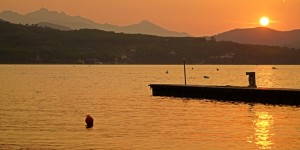 As a whole, Elba has not disappointed me. I was lucky to stay in Magazini which is lovely and quiet. I discover Hotel Mare near Residence Alithai which has become my favourite spot to watch sunset over Portoferraio. Its price for a single person at low season is very affordable: €61 for B&B and €73 half board. I love to spend a night there. Unfortunately it was fully booked. Anyway, I watched sunset three times and had dinner twice at Hotel Mare.
As a whole, Elba has not disappointed me. I was lucky to stay in Magazini which is lovely and quiet. I discover Hotel Mare near Residence Alithai which has become my favourite spot to watch sunset over Portoferraio. Its price for a single person at low season is very affordable: €61 for B&B and €73 half board. I love to spend a night there. Unfortunately it was fully booked. Anyway, I watched sunset three times and had dinner twice at Hotel Mare.
Elba though small, is compact and beautiful with lots to do. I would have easily spent a few more days so that I could have taken a few more walks and excursions to the smaller Tuscan islands in the archipelago namely Capraia, Giglio, Giannutri, Gorgona, Pianosa and Montecristo.
I am disappointed by the lack of information on Napoleon’s legacy on the island. The information available to visitors in St Helena is much better. The setting of Napoleon’s house and garden and the empty tomb in St Helena are much more interesting and atmospheric. Hence, I have a better feel about the place and the melancholy of a hero in his last days. But I hardly know sense Napoleon’s passage through Elba. What a pity!



